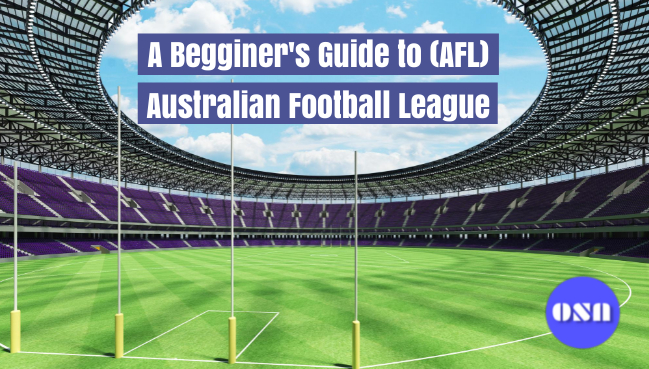A Beginner’s Guide To AFL (Australian Football League)

The Australian Football League is one of the most popular sports in Australia, second only to Cricket.
If you are an expat living in Australia or just visiting or international student, it can be difficult to understand the rules and how the game is played.
In this Beginner’s Guide to AFL, we will break down all the important terms and go over some basic strategies to help you gain a better understanding of AFL.
A brief history of AFL
Actual origins of the Australian Football League are still a matter of debate. Although, here is a quick rundown of the history of this sport as we know.
Australian Rules football, more commonly known as AFL, is a sport which was created in Melbourne, Victoria in 1858.
Three different Melbourne schools competed in a number of football matches in the cold of 1858. These contests are said to be the very first official Australian Rules football games. Regular games in Melbourne started in 1859 after a set of AFL rules had been developed.
By the 1870s, audiences of up to 10,000 people were attending the distinctively Australian sport. The contest became a national sport.
The game may have drawn some of its inspiration from an indigenous game and Irish Gaelic football. However, the game was mostly modelled by the game of football used in English public education.
Various schools had different football regulations. This meant that a lot of effort was spent deciding which set of rules would be applied when games took place between schools.
AFL- Single Set of Rules
It was in May, 1859 when the AFL-single set of rules was drafted by Thomas Wills and 6 other members from Melbourne Cricket Club.
In accordance with these regulations, which were revised throughout the course of the following ten years, a player might hold the ball and kick it at any moment, but they were not permitted to toss it.
Additionally, in order to score a goal, the ball must be booted through the net rather than carried.
How Was the Game Organised?
Workplaces, schools and churches established their own football teams. Games were initially played in parks. But football had begun to gain popularity by the 1870s. Crowds paid to see the games, which were shifted from parks to cricket fields.
It was in May, 1877 when the VFA or Victorian Football Association was established in order to oversee football games in Victoria. The VFA promoted participation, developed new regulations, and supplied umpires for major matches.
In 1896, eight of the VFA’s top teams formed a pro football league named Victorian Football League. The VFL concentrated on enhancing the game’s speed and entertainment value. Additionally, they generated money by selling spectators’ tickets. Over the course of time, many clubs joined VFL.
How AFL became popular?
Tasmania, Western Australia and South Australia- all adopted the sport in the 1880s, giving it the name “Australian Rules”. In addition to this, you must know that Rugby League and Union remained the most widely played football formats in the Queensland and New South Wales.
The Australian Football League, often known as the AFL, took the place of the Victorian Football League in 1990. Since that moment various clubs from New South Wales, Western Australia, Queensland, South Australia joined the league.
This uniquely Australian sport continues to develop every year as new players, regulations, and technology are introduced.
How to Score in AFL?
Each of the two 18-player teams competes against the other.
Their primary purpose is to place a ball between a quartet of goalposts. Which crossbar the ball touches determines exactly how many points the team scores.
Players are not permitted to throw the ball; instead, they may kick it or punch it off their palm to transfer it to a teammate.
Unless a tie-break or a declared draw is used, the side with the most points at the conclusion of the game wins.
Basic AFL Rules for dummies
Here are some must know rules about the Australian Football League (AFL)
- AFL is played on an oval-shaped pitch (oval shaped ball) with goalposts at either end.
- Only 18 of each team’s 22 players participate on the field. Other 4 are substitutes and can be replaced anytime.
- Australian Football League is divided into 4 quarters. The duration of each quarter is 20 minutes.
- More time is also given if an umpire signals time out.
- All judgments are made by the umpire, whose decision is final.
- The game starts with a center bounce.
- Then, a member from each side tries to touch the ball.
- Players can move the ball in three ways running. Players can use their fist or kick it. If the ball remains too high, you can catch the ball by jumping.
- Players must make sure that they are bouncing the ball every 16 yards.
- In order to score, the players will have to throw the ball through the two large upright posts. It will give their team 6 points.
- However, if you hit the post or send the ball between the outer large and lower post, it is worth 1 point only. It is called a ‘behind’.
- The game resumes in the same manner as it did at the start once a goal is scored.
- A team will get a free kick if one of the players catches a kick greater than 15 metres. It’s also known as “mark”.
- The player who catches (or mark) the ball cannot be challenged until it has been kicked.
- He is given the freedom to execute the following play without any interruptions.
- The side in possession of the ball advances 15 metres down the field if an opponent steps beyond the mark or makes a tackle.
- To recover the ball, players are permitted to tackle the opposing team, but they can only do it from shoulder height and below.
- If a player is being tackled and won’t release the ball, the umpire will call out and the ball will be handed over.
- When sprinting or engaged in a tackle, players cannot shove their rivals from the rear.
- Another unique thing about this game is that there is no offside rule.
Different Positions in the AFL
If you want to understand AFL deeply, you need to know the different players’ position in the game. We have named them below:
- Ruckman: The Ruckman is the player on the team that defends their goal post, as well as tries to win possession of the ball during stoppages. They need a lot of height, strength, and ability to cover ground.
Teams typically only have one Ruckman on the field, but they can also use taller players on the defence or the forward line to fill in as the “back-up ruckman” during ruck competitions.
- Defenders: As the name implies, these guys are protecting the goal from the other team.
By tackling the opponent, marking the ball, sabotaging kicks and locating midfielders up the field while in control of the ball, these players are attempting to divert the ball away from the goal.
The first defender is called a defender and his or her role is to mainly stay back and control any advances into their side of the ground while reading what plays the opposition will make.
They also need to position themselves so that they can be seen by their teammates downfield in order to communicate with them when necessary. If an opponent manages to break through, it’s important for this player to have excellent tackling skills so that they can stop them from scoring.
The second defender is usually referred to as an outside back or wingman and their job is usually about helping in any way possible.
- Midfielders: These players serve as the team’s heart and soul. These players hold the ball in large numbers as it travels from one end to the other and back again.
If the midfielders have the ball, they should search for another midfielder or a striker who can score. A player who is nearer to the ball and tries to take possession of it from the opposition by tackling or stealing passes is known as an “inside midfielder.”
An “outsider midfielder,” on the other hand, tries to distance themselves from their opponent. They aim to advance in the possession chain as the following participant.
- Forwards: To counter the defensive and playing styles of the opposition, forwards come in a variety of sizes.
Key forwards are big, athletic individuals who track the high ball and make all-around goal kicks.
To avoid tackling as well as kicking goals, “crumbing” forwards, who are smaller in stature but quick and intrusive, play below the key-forwards.
List of Teams in AFL
Currently, there are 18 teams playing in the Australian Football League.
Here is a list of all the teams and their nickname that are currently playing in Australian Football League (AFL)
- Adelaide – Crows
- Brisbane – Lions
- Carlton – Blues
- Collingwood – Magpies
- Essendon – Bombers
- Fremantle – Dockers
- Geelong – Cats
- Greater Western Sydney- Giants
- Gold Coast – Suns
- Hawthorn – Hawks
- North Melbourne – Kangaroos
- Melbourne – Demons
- Port Adelaide – Power
- Richmond – Tigers
- St Kilda – Saints
- Sydney – Swans
- West Coast – Eagles
- Western Bulldogs – Bulldogs
How is AFL tournament played?
A total of 18 teams plays in the home and away games each other in the AFL league. These games will occur during the winter months between March and September.
Top 8 teams will qualify for the finals after the home and away round. These 8 top teams will compete in 4-week final series. And the final 2 teams will proceed to play in the Grand final.
Grand final is usually played each year on the last Saturday of September at the Melbourne Cricket Ground (MCG) in Victoria.
The winner of the final will take the premiership cup and the premiership flag.
There is also a public holiday on the AFL final eve (Friday prior to the AFL final) in Victoria.
In 2022, the AFL Grand final will be played on Saturday 24th September 2022 at the Melbourne Cricket Ground (MCG).
Reasons To Watch AFL
The Australian Football League (AFL) has been one of the most popular sports in Australia since its inception in the 19th century. Here, we have added the top reasons to watch AFL.
- Game Is Easy to Understand: Watching and understanding an AFL game is pretty easy once you know what’s going on.
For example, teams try to score points by kicking or handballing the ball into one of three different goal posts: left, center and right.
- Players are Very Accessible: When you go to an AFL game, not only are you getting a chance to see some amazing football, but you can also meet players and get autographs and photos with them.
Players in Australia are used to interacting with fans of the game because so many people play footy. This helps them become role models for younger players and show that they should always be open and friendly.
So, this is all about Australian Football League or AFL in short. We hope that you have understood how this game is played. An AFL game unites Australians of all ages.
You can interact with new people and fit in with Australian sports culture. Everyone will be applauding and chanting for their preferred sides during the game. So, next time, when you see an AFL match is going on, do not miss it.


